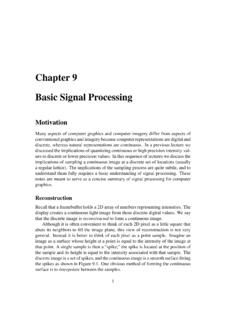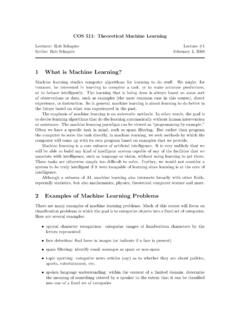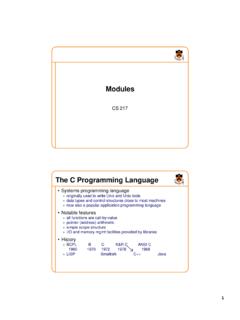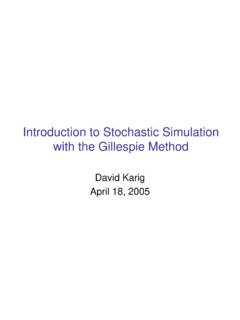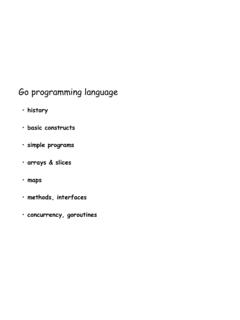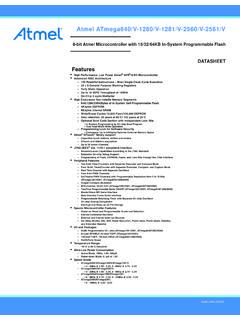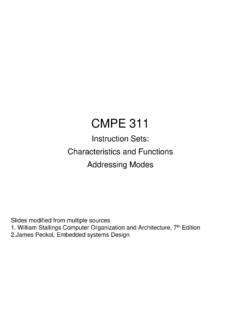Transcription of Assembly Language: Part 1 - Princeton University
1 1 Assembly Language: Part 1 Princeton UniversityComputer Science 217: Introduction to Programming Systems1 First half of the semester: Programming in the large Second half: Under the hood Context of this Lecture2 Starting NowLaterC LanguageAssembly LanguageMachine LanguageApplication ProgramOperating SystemHardwarelanguagelevelstourservicel evelstour2 Lectures vs. PreceptsLecturesPreceptsStudy partial pgmsStudy complete pgmsBegin with simpleconstructs; proceed to complex onesBegin with small pgms; proceed to large onesEmphasis on reading codeEmphasis on writingcodeApproach to studying Assembly Language: 3 AgendaLanguage LevelsArchitectureAssembly Language: Performing ArithmeticAssembly Language: Load/Store and Defining Global Data4 High-Level LanguagesCharacteristics Portable To varying degrees Complex One statement can do much work good ratio offunctionality to code size Human readable Structured if(), for(), while(), = 0;while (n>1){ count++;if (n&1)n = n*3+1;elsen = n/2.}
2 }6 Machine LanguagesCharacteristics Not portable Specific to hardware Simple Each instruction does asimple task poor ratio offunctionality to code size Not human readable Not structured Requires lots of effort! Requires tool support0000 0000 0000 0000 0000 0000 0000 00000000 0000 0000 0000 0000 0000 0000 00009222 9120 1121 A120 1121 A121 7211 00000000 0001 0002 0003 0004 0005 0006 00070008 0009 000A 000B 000C 000D 000E 000F0000 0000 0000 FE10 FACE CAFE ACED CEDE1234 5678 9 ABC DEF0 0000 0000 F00D 00000000 0000 EEEE 1111 EEEE 1111 0000 0000B1B2 F1F5 0000 0000 0000 0000 0000 0000 Assembly LanguagesCharacteristics Not portable Each Assembly langinstruction maps to one machine langinstruction Simple Each instruction does a simple task Human readable(In the same sense that Polish ishuman readable, if you know Polish.)
3 7andswzr, w0, #1beqelsebendifelse:endif:asrw0, w0, 1addw2, w0, w0addw0, w0, w2addw0, w0, 1addw0, w0, #1loop:cmpw0, 1bleendloopbloopendloop:movw1, 08 Why Learn Assembly Language?Q: Why learn Assembly language?A: Knowing Assembly language helps you: Write faster code In Assembly language In a high-level language! Write safer code Understanding mechanism of potential security problemshelps you avoid them even in high-level languages Understand what s happening under the hood Someone needs to develop future computer systems Maybe that will be you! Become more comfortable with levels of abstraction Become a better programmer!9 Why Learn ARM Assembly Lang?Why learn ARMv8 ( AARCH64) Assembly language?Pros ARM is the most widely used processor in the world (in your phone, in your Chromebook, in the internet-of-things, Armlab) ARM has a modern and (relatively) elegant instruction set, compared to the big and ugly x86-64 instruction setCons x86-64 dominates the desktop/laptop, for now(but there are rumors that Apple is going to shift Macs to )AgendaLanguage LevelsArchitectureAssembly Language: Performing ArithmeticAssembly Language.
4 Load/Store and Defining Global Data10 John Von Neumann (1903-1957)In computing Stored program computers Cellular automata Self-replicationOther interests Mathematics Inventor of game theory Nuclear physics (hydrogen bomb) Princeton connection Princeton Univ & IAS, 1930-1957 Known for Von Neumann architecture (1950) In which programs are just data in the memory Contrast to the now-obsolete Harvard architecture 1111 Von Neumann Architecture12 RAMC ontrolUnitCPUR egistersData busALUI nstructions (encoded within words)are fetched from RAMC ontrol unit interprets instructions to shuffle data between registers and RAM to move data from registers to ALU (arithmetic+logicunit) where operations are performed 12 Von Neumann Architecture13 RAMC ontrolUnitCPUR egistersData busALURAM (Random Access Memory)Conceptually: large array of bytes(gigabytes+ in modern machines) Contains data (program variables, structs, arrays) and the program!
5 instructions are fetched from RAM13 Von Neumann Architecture14 RAMC ontrolUnitCPUR egistersData busALU14 RegistersSmall amount of storage on the CPU(tens of words in modern machines) Much faster than RAM Top of the storage hierarchy :above RAM, disk, (arithmetic+logicunit) instructionsoperate on registers15 Registers and RAMT ypical pattern: Load data from RAM to registers Manipulate data in registers Store data from registers to RAMOn AARCH64, this pattern is enforced Manipulation instructions can onlyaccess registers This is known as a Load/store architecture Characteristic of RISC ( reduced Instruction Set computer ) vs. CISC (Complex Instruction Set computer ) architectures, x8615 Registers (ARM-64 architecture)1616x0w063 31 0 (FP)w29x30 (LR)w30xzr (all zeros)wzrsp (stack pointer)pc (program counter)nzcvpstateGeneral-Purpose RegistersX0.
6 X30 64-bit registers Scratch space for instructions , parameter passing to/from functions, return address for function calls, etc. Some have special purposes defined in hardware ( X30)or defined by software convention ( X29) Also available as 32-bit versions: W0 .. W30 XZR On read: all zeros On write: data thrown away1717SP RegisterSpecial-purpose Contains SP (Stack Pointer):address of top (low address) ofcurrent function s stack frameAllows use of the STACK section of memory(See Assembly Language: Function Calls lecture)18 SPSTACK framelow memoryhigh memory1819PC RegisterSpecial-purpose Contains PC (Program Counter) Stores the location of the next instruction Address (in TEXT section) of machine-languageinstructions to be executed next Value changed: Automatically to implement sequential control flow By branch instructions to implement selection, repetitionPCTEXT section19 PSTATE RegisterSpecial-purpose Contains condition flags.
7 N (Negative), z (Zero), c (Carry), v (oVerflow) Affected by compare (cmp) instruction And many others, if requested Used by conditional branch instructions beq, bne, blo, bhi, ble, bge, .. (See Assembly Language: Part 2 lecture)2020nzcvpstateAgendaLanguage LevelsArchitectureAssembly Language: Performing ArithmeticAssembly Language: Load/Store and Defining Global Data21 ALU22 RAMC ontrolUnitCPUR egistersData busALU22 ALUsrc1src2destoperationALUPSTATEI nstruction FormatMany instructions have this format: name:name of the instruction (add, sub, mul, and, etc.) s:if present, specifies that condition flags should be set dest and src1,src2 are xregisters: 64-bit operation dest and src1,src2 are wregisters: 32-bit operation src2 may be a constant ( immediate value) instead of a registername{,s} dest, src1, src2name{,s} dest, src1, immed2323 ALUsrc1src2destoperationALUPSTATE64-bit Arithmetic24static long length;static long width;static long perim.
8 Perim =(length + width) * 2;addx3, x1, x2lslx3, x3, 124 Assume length stored in x1 width stored in x2 perimstored in x3We ll see later how tomake this happenAssembly code:C code:Recall use of left shift by 1 bit to multiply by 2 More Arithmetic25static long x;static long y;static long z;..z = x -y;z = x * y;z = x / y;z = x z = x | y;z = x ^ y;z = x >> y;subx3, x1, x2mulx3, x1, x2sdivx3, x1, x2andx3, x1, x2orrx3, x1, x2eorx3, x1, x2asrx3, x1, x225 Assume x stored in x1 y stored in x2 z stored in x3We ll see later how tomake this happenNote arithmetic shift! Logical right shift with lsrinstructionMore Arithmetic: Shortcuts26static long x;static long y;static long z;..z = x;z = -x;movx3, x1negx3, x126 Assume x stored in x1 y stored in x2 z stored in x3We ll see later how tomake this happenThese are actually assembler shortcuts for instructions with XZR!
9 Orrx3, xzr, x1subx3, xzr, x1 Signed vs Unsigned?27static long x;static unsigned long y;..x++;y--;addx1, x1, 1subx2, x2, 127 Assume x stored in x1 y stored in x2 Mostly the same algorithms, same instructions ! Can set different condition flags in PSTATE Exception is division: sdivvs udivinstructions32-bit Arithmetic28static int length;static int width;static int perim;..perim =(length + width) * 2;addw3, w1, w2lslw3, w3, 128 Assume length stored in w1 width stored in w2 perimstored in w3We ll see later how tomake this happenAssembly code using w registers:8- and 16-bit Arithmetic?29static char x;static short y;..x++;y--;29No specialized instructions Use w registers Specialized load and store instructions for transfer of shorter data types from / to memory we ll see these later Corresponds to C language semantics: all arithmetic is implicitly done on (at least) intsAgendaLanguage LevelsArchitectureAssembly Language: Performing ArithmeticAssembly Language: Load/Store and Defining Global Data30 Loads and StoresMost basic way to load (from RAM) and store (to RAM): dest and src are registers!
10 Registers in [brackets] contain memory addresses Every memory access is through a pointer ! How to get correct memory address into register? Depends on whether data is on stack (local variables),heap (dynamically-allocated memory), or global / static For today, we ll look only at the global / static caseldr dest, [src]str src, [dest]3131 Loads and Stores32static int length = 1;static int width = 2;static int perim = 0;int main(){perim =(length + width) * 2;return 0;}.section .datalength:.word 1width:.word 2perim:.word . mainmain:adrx0, lengthldrw1, [x0]adrx0, widthldrw2, [x0]addw1, w1, w2lslw1, w1, 1adrx0, perimstrw1, [x0]movw0, 0ret32 Loads and Stores33static int length = 1;static int width = 2;static int perim = 0;int main(){perim =(length + width) * 2;return 0;}.
